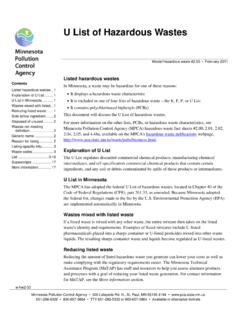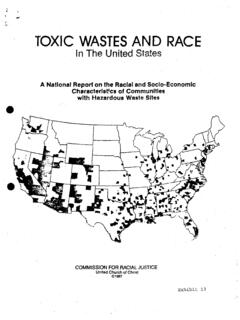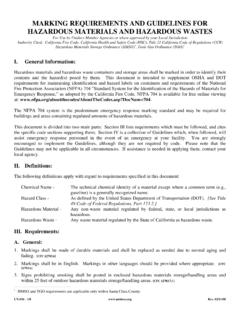Transcription of Waste Characterization Guidance - Michigan
1 800-662-9278 March 2020 Waste Characterization AND hazardous Waste GENERATOR STATUS Guidance Waste Characterization DETERMINATION Michigan s hazardous Waste and liquid industrial by-products regulations apply to facilities generating Waste . The only exception is for Waste generated at a residence that is composed primarily of materials found in wastes generated by consumers in their homes (household Waste ). The hazardous Waste and liquid industrial by-products regulations apply to all businesses (for profit and non-profit), municipalities, healthcare providers, service industries, administrative offices, churches, etc.
2 The environmental Waste regulations were written broadly to ensure that unwanted materials are handled, recycled, and disposed safely in a manner that protects public health, safety, and our environment. They were also written to encourage reuse, recycling, and the use of less toxic materials. As a result, they provide regulatory relief to facilities that minimize the amount and toxicity of the hazardous Waste they generate. Unwanted materials that can no longer be used for their original intended purpose without first being reclaimed or recycled are subject to Waste regulations implemented by the Michigan Department of Environment, Great Lakes, and Energy (EGLE), Materials Management Division.
3 Most Waste materials are classified as either a hazardous Waste , liquid industrial by-product, or solid Waste . When evaluating a Waste to determine how it is classified, the Waste regulations require Waste generators to follow prescriptive steps. If the materials used at the site change, the processes that produce the Waste change, or the nature of the Waste changes due to storage and/or handling, the Waste must be re-evaluated. This Guidance provides details about how to characterize Waste and how to determine a site s generator category, also called generator status.
4 I t clarifies who does the Characterization , the Characterization steps, common tests, and common exemptions or exclusions from hazardous Waste regulation. Accurate Characterization and generator category determination is important because if you don t know what type of Waste you have or your hazardous Waste generator category, you cannot determine the handling, recycling, and disposal requirements that apply to your unwanted materials. WHO IS RESPONSIBLE FOR Waste Characterization ? Everyone handling or managing a Waste stream is both personally and professionally responsible for properly managing the Waste from its cradle to grave, beginning with performing a representative, accurate Waste determination.
5 "Cradle-to -grave" responsibilities and liabilities apply to the generator, transporter, and the receiving treatment, storage, and disposal facility. WHO DOES THE Waste Characterization ? A site generating Waste may: Hire a consultant or use a disposal company s Waste Characterization services to characterize each of its Waste streams. When someone else characterizes a generator s Waste , the Waste generator remains responsible for proper Characterization , handling, and recycling or disposal. As a result, understanding the basic Waste Characterization principles is key to ensuring a consultant or disposal vendor is providing the services you need to ensure compliance.
6 Characterize each Waste stream using site staff with technical expertise in making Waste Characterization determinations. Waste Characterization Guidance - 2 - WHEN MUST A Waste Characterization DETERMINATION BE PERFORMED? A Waste generator must evaluate the Waste to determine if it is considered a listed or characteristically hazardous Waste at the point of generation, before any dilution, mixing, or other alteration of the Waste occurs. The point of generation for a listed hazardous Waste is when it first meets the listing description.
7 The point of generation for a mixture of listed hazardous Waste with other Waste is when the Waste materials are mixed. The point of generation for a characteristically hazardous Waste is when the Waste first exhibits the characteristic of ignitability, corrosivity, reactivity and/or toxicity. WHAT ARE THE Waste Characterization STEPS? To ensure each Waste stream is identified and properly evaluated, a Waste survey should be conducted. Walk through the entire site. Make a list of all the Waste streams regardless of whether they are recycled or disposed.
8 hazardous Waste and liquid industrial by-products can be found on the shop/plant floor, in production or service areas, in offices, etc. Other hazardous wastes or liquid industrial by-products can be incidentally generated from building (expansion and renovation) or property maintenance activities. Consider evaluating new products before purchase so their handling and recycling or disposal requirements and costs are known in advance of generating a new Waste stream. The following are some commonly generated hazardous wastes that may be overlooked and the reasons why they may be hazardous noted in parenthesis.
9 Spent fluorescent lamps or bulbs and other lighting fixtures (toxic for mercury and other metals). Disposable rags containing free liquids with a flashpoint of less than 140 degrees Fahrenheit or used with a listed solvent (ignitability, spontaneous combustion, used with F listed solvents). Spent activated carbon media, included in some air filters (may contain F listed solvents). Used solvents with low flashpoint (toxic, ignitability). Used solvents with high flashpoints (toxic). Drain or sump sludge, including loading/unloading area trenches (toxic and ignitability due to gasoline from trucks or other spills).
10 Painting materials and Waste including paint thinners, enamel reducers, epoxies, primers, enamels, solvent-based paints, and paint booth filters (contains F listed solvents, toxic metals, ignitability). Aerosol cans that are not empty (contains U or P chemicals, ignitability. toxic). Solvent-based adhesives (ignitability). Batteries - lead acid (toxic for lead and corrosive acids), lithium (reactive and ignitable), and dry cell (sometimes toxic for lead and mercury). Used water-based or synthetic lubricating fluids containing high concentrations of heavy metals (toxic metals of concern include lead, chromium, cadmium, and barium).

















